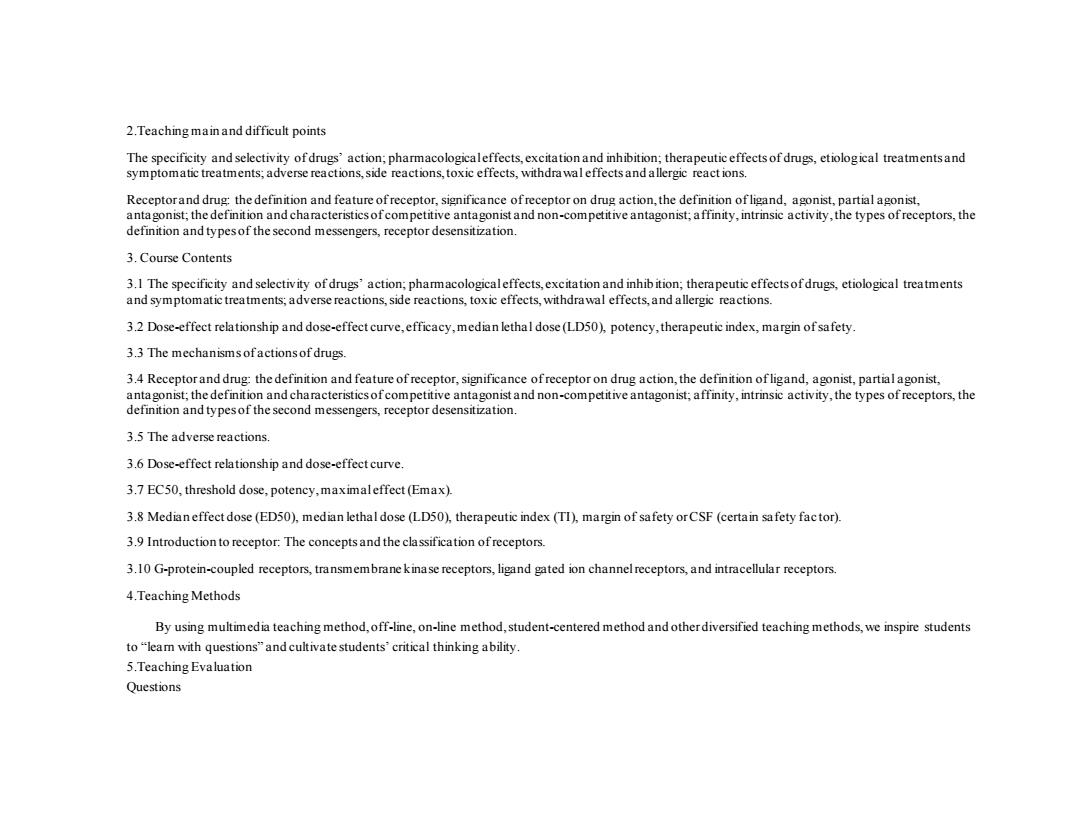正在加载图片...

2.Teaching main and difficult points The specificity and selectivity ofdrugs'action;pharmacologicaleffects,excitation and inhibition;therapeutic effects of drugs,etiological treatmentsand symptomatic treatments;adverse reactions,side reactions,toxic effects,withdrawal effectsand allergic react ions. Receptorand drug:the definition and feature ofreceptor,significance ofreceptor on drug action,the definition of ligand,agonist,partial agonist, antagonist;the definition and characteristics ofcompetitive antagonist and non-competitive antagonist,affinity,intrinsic activity,the types ofreceptors,the definition and types of the second messengers,receptor desensitization. 3.Course Contents 3.1 The specificity and selectivity of drugs'action;pharmacologicaleffects,excitation and inhib ition;therapeutic effects ofdrugs,etiological treatments and symptomatic treatments;adverse reactions,side reactions,toxic effects,withdrawal effects,and allergic reactions. 3.2 Dose-effect relationship and dose-effect curve,efficacy,median lethal dose(LD50),potency,therapeutic index,margin of safety 3.3 The mechanisms ofactions of drugs. 3.4 Receptor and drug:the definition and feature of receptor,significance of receptor on drug action,the definition of ligand,agonist,partial agonist, antagonist;the definition and characteristics ofcompetitive antagonist and non-competitive antagonist;affinity,intrinsic activity,the types of receptors,the definition and types of the second messengers,receptor desensitization. 3.5 The adverse reactions. 3.6 Dose-effect relationship and dose-effect curve. 3.7 EC50,threshold dose,potency,maximaleffect(Emax). 3.8 Medianeffect dose(ED50),median lethal dose(LD50),therapeutic index(TI),margin of safety or CSF(certain safety factor). 3.9 Introduction to receptor:The concepts and the classification ofreceptors. 3.10 G-protein-coupled receptors,transmembrane kinase receptors,ligand gated ion channel receptors,and intracellular receptors. 4.Teaching Methods By using multimedia teaching method,off-line,on-line method,student-centered method and other diversified teaching methods,we inspire students to"leam with questions"and cultivate students'critical thinking ability. 5.Teaching Evaluation Questions2.Teaching main and difficult points The specificity and selectivity of drugs’ action; pharmacological effects, excitation and inhibition; therapeutic effects of drugs, etiological treatments and symptomatic treatments; adverse reactions, side reactions, toxic effects, withdrawal effects and allergic reactions. Receptor and drug: the definition and feature of receptor, significance of receptor on drug action, the definition of ligand, agonist, partial agonist, antagonist; the definition and characteristics of competitive antagonist and non-competitive antagonist; affinity, intrinsic activity, the types of receptors, the definition and types of the second messengers, receptor desensitization. 3. Course Contents 3.1 The specificity and selectivity of drugs’ action; pharmacological effects, excitation and inhib ition; therapeutic effects of drugs, etiological treatments and symptomatic treatments; adverse reactions, side reactions, toxic effects, withdrawal effects, and allergic reactions. 3.2 Dose-effect relationship and dose-effect curve, efficacy, median letha l dose (LD50), potency, therapeutic index, margin of safety. 3.3 The mechanisms of actions of drugs. 3.4 Receptor and drug: the definition and feature of receptor, significance of receptor on drug action, the definition of ligand, agonist, partial agonist, antagonist; the definition and characteristics of competitive antagonist and non-competitive antagonist; affinity, intrinsic activity, the types of receptors, the definition and types of the second messengers, receptor desensitization. 3.5 The adverse rea ctions. 3.6 Dose-effect relationship and dose-effect curve. 3.7 EC50, threshold dose, potency, maximal effect (Emax). 3.8 Median effect dose (ED50), median lethal dose (LD50), therapeutic index (TI), margin of safety or CSF (certain safety fac tor). 3.9 Introduction to receptor: The concepts and the classification of receptors. 3.10 G-protein-coupled receptors, transmembrane kinase receptors, ligand gated ion channel receptors, and intracellular receptors. 4.Teaching Methods By using multimedia teaching method, off-line, on-line method, student-centered method and other diversified teaching methods, we inspire students to “learn with questions” and cultivate students’ critical thinking ability. 5.Teaching Evaluation Questions